Design Criteria for the Construction of Energy Storage Salt Cavern Considering Economic Benefits and Resource Utilization
Abstract
1. Introduction
1.1. Construction Requirements and Process of Rock Salt Storage
1.2. Importance of Construction Design and Shape Control
1.3. Shortcomings of the Current Research
1.4. The Research Purpose of This Paper
2. Data Acquisition
2.1. Cavern Construction Design Parameters
2.2. Expected Revenue and Resource Utilization
3. Analysis and Discussion of the Main Design Parameters
3.1. Distance between the Inner Tube and the Oil Pad
3.2. Lifting Height of the Inner Tube and the Oil Pad
3.3. Ratio of the Lifting Height to Duration
4. Conclusions
Author Contributions
Funding
Institutional Review Board Statement
Informed Consent Statement
Data Availability Statement
Conflicts of Interest
Nomenclature
| m | Meter |
| m3 | Cubic meter |
| ¥ | Chinese ¥ |
| Vg | Working gas volume, m3 |
| Mmol | Molar mass of natural gas, g/mol |
| Vs | Effective capacity of the storage, m3 |
| Vc | Volume of circulation zone, m3 |
| Vd | Volume of the dead zone under inner tube, m3 |
| C | Brine concentration in the circulation, g/L |
| r | Radius in the column coordinate system |
| Θ | Angle in the column coordinate system |
| z | Height in the column coordinate system |
| t | Time, s |
| Cs | Saturated concentration, g/L |
| D | Scattering coefficient |
| Q | Flow of injected water, m3/h |
| U | Insoluble content of the micro-element on point |
| u | Content of insoluble in the salt |
| ρs | Density of rock salt, kg/m3 |
| ρ | Density of natural gas, kg/m3 |
| R | Universal gas constant, 8.314 J/(mol·K) |
| Pmax | Maximum pressures inside salt caverns, kPa |
| Pmin | Minimum pressures inside salt caverns, kPa |
| Zmax | Compression coefficients at the maximum internal pressures |
| Zmin | Compression coefficients at the minimum internal pressures |
| Tmax | Maximum temperature at injection, K |
| Tmin | Minimum temperature at discharge, K |
| fc | Capacity coefficient |
| Average capacity coefficient | |
| Vk | Cavern volume kth of the n groups data, m3 |
| Average volume when the process parameter is equal to j, m3 | |
| rmax | Maximum radius, m |
| W | Safe distance between adjacent caverns, m |
| Hc | Cavern height, m |
| H | Distance between the inner tube and oil pad, m |
| hi | Lifting height of stage i, m |
| ho | Lifting height of oil pad, m |
| hI | Lifting height of inner tube, m |
| ti | Duration, day |
| Average distance between the inner tube and oil pad, m | |
| Weighted average distance between the inner tube and oil pad, m | |
| Average lifting height, m | |
| Ratio of lifting height to duration, m/day | |
| i | Stage i |
| n | n groups data |
| k | Group k of the n groups data, summation index |
| j | The process parameters are rounded down to a value equal to j |
| rounddown (x, 0) | Function of the round down toward zero, for example, rounddown (23.7, 0) = 23, rounddown (−23.2, 0) = −23 |
References
- Mortazavi, A.; Nasab, H. Analysis of the behavior of large underground oil storage caverns in salt rock. Int. J. Numer. Anal. Methods. Geomech. 2017, 41, 602–624. [Google Scholar] [CrossRef]
- Yang, C.; Wang, T.; Li, Y.; Yang, H.; Li, J.; Qu, D.; Xu, B.; Yang, Y.; Daemen, J.J.K. Feasibility analysis of using abandoned salt caverns for large-scale underground energy storage in China. Appl. Energy 2015, 137, 467–481. [Google Scholar] [CrossRef]
- Liu, W.; Zhang, Z.; Chen, J.; Fan, J.; Jiang, D.; Daemen, J.J.K.; Li, Y. Physical simulation of construction and control of two butted-well horizontal cavern energy storage using large molded rock salt specimens. Energy 2019, 185, 682–694. [Google Scholar] [CrossRef]
- Zhang, N.; Liu, W.; Zhang, Y.; Shan, P.; Shi, X. Microscopic pore structure of surrounding rock for underground strategic petroleum reserve (SPR) caverns in bedded rock salt. Energies 2020, 13, 1565. [Google Scholar] [CrossRef]
- Zhang, N.; Ma, J.; Wang, M.; Zhang, Q.; Li, J.; Fan, P. Comprehensive risk evaluation of underground energy storage caverns in bedded rock salt. J. Loss Prevent. Proc. 2016, 45, 264–276. [Google Scholar] [CrossRef]
- Li, J.; Wang, Z.; Zhang, S.; Shi, X.; Xu, W.; Zhuang, D.; Liu, J.; Li, Q.; Chen, Y. Machine-learning-based capacity prediction and construction parameter optimization for energy storage salt caverns. Energy 2022, 254, 124238. [Google Scholar] [CrossRef]
- Ling, D.; Zhu, S.; Zheng, J.; Xu, Z.; Zhao, Y.; Chen, L.; Shi, X.; Li, J. A simulation method for the dissolution construction of salt cavern energy storage with the interface angle considered. Energy 2023, 263, 125792. [Google Scholar] [CrossRef]
- Li, J.; Shi, X.; Yang, C.; Li, Y.; Wang, T.; Ma, H. Mathematical model of salt cavern leaching for gas storage in high-insoluble salt formations. Sci. Rep. 2018, 8, 372. [Google Scholar] [CrossRef]
- Yang, J.; Li, H.; Yang, C.; Li, Y.; Wang, T.; Shi, X.; Han, Y. Physical simulation of flow field and construction process of horizontal salt cavern for natural gas storage. J. Nat. Gas. Sci. Eng. 2020, 82, 103527. [Google Scholar] [CrossRef]
- Li, L.; Rivas, E.; Gracie, R.; Dusseault, M.B. Methodology for the nonlinear coupled multi-physics simulation of mineral dissolution. Int. J. Numer. Anal. Methods Geomech. 2021, 45, 2193–2213. [Google Scholar] [CrossRef]
- Yang, C.; Wang, T.; Qu, D.; Ma, H.; Li, Y.; Shi, X.; Daemen, J.J.K. Feasibility analysis of using horizontal caverns for underground gas storage: A case study of Yunying salt district. J. Nat. Gas. Sci. Eng. 2016, 36, 252–266. [Google Scholar] [CrossRef]
- Wang, T.; Yang, C.; Li, J.; Li, J.; Shi, X.; Ma, H. Failure analysis of overhanging blocks in the walls of a gas storage salt cavern: A case study. Rock. Mech. Rock. Eng. 2017, 50, 125–137. [Google Scholar] [CrossRef]
- Li, J.; Shi, X.; Zhang, S. Construction modeling and parameter optimization of multi-step horizontal energy storage salt caverns. Energy 2020, 203, 117840. [Google Scholar] [CrossRef]
- Durie, R.W.; Jessen, F.W. The influence of surface features in the salt dissolution process. SPE J. 1964, 4, 275–281. [Google Scholar] [CrossRef]
- Durie, R.W.; Jessen, F.W. Mechanism of the dissolution of salt in the formation of underground salt cavities. SPE J. 1964, 4, 183–190. [Google Scholar] [CrossRef]
- Kazemi, H.; Jessen, F.W. Mechanism of flow and controlled dissolution of salt in solution mining. Soc. Pet. Eng. J. 1964, 4, 317–328. [Google Scholar]
- Reda, D.C.; Russo, A.J. Experimental studies of salt-cavity leaching by freshwater injection. SPE Prod. Eng. 1986, 1, 82–86. [Google Scholar] [CrossRef]
- Li, L.; Gracie, R.; Dusseault, M.B.; Xiao, N.; Liang, W. Modeling and verification of non-linear mineral dissolution processes with buoyancy effects. Int. J. Rock. Mech. Min. 2023, 161, 105257. [Google Scholar] [CrossRef]
- Xiao, N.; Liang, W.; Yu, Y.; Zhang, S.; Li, L. Shape prediction and parameter optimization of single-well retreating horizontal salt cavern for energy storage. J. Energy Storage 2023, 59, 106557. [Google Scholar] [CrossRef]
- Saberian, A. Numerical Simulation of Development of Solution-Mined Storage Cavities. Ph.D. Thesis, University of Texas System, Austin, TX, USA, 1974. [Google Scholar]
- Kunstman, A.; Urbanczyk, K. Application of WinUbro software to modelling of carven development in trona deposit. In Proceedings of the Solution Mining Research Institute Technical Conference, Krakow, Poland, 27–28 April 2009. [Google Scholar]
- Wan, J.; Peng, T.; Shen, R.; Jurado, M. Numerical model and program development of TWH salt cavern construction for UGS. J. Pet. Sci. Eng. 2019, 179, 930–940. [Google Scholar] [CrossRef]
- Wang, Y.; Zhou, D.; Deng, L.; Fu, Y.; Guan, D. Study on improving the solution-mining processes of salt-cavern gas storage and field applications of the improved process technology. J. Southwest Pet. Univ. 2018, 5, 1674–5086. [Google Scholar] [CrossRef]
- Wang, J.; Zhu, K.; Li, Y.; Fan, L.; Wang, W.; Ge, C. Optimization of key cavity construction parameters of Jintan salt-cavern gas storage. Oil Drill. Prod. Technol. 2020, 4, 471–475. [Google Scholar] [CrossRef]
- Ren, S.; Tang, K.; Yi, L.; Chen, J.; Liu, W. Research on two-well solution mining cavity expansion with small well space. Chin. J. Undergr. Space Eng. 2017, 14, 805–812. [Google Scholar]
- Wan, J.; Peng, T.; Jurado, M.J.; Shen, R.; Yuan, G.; Ban, F. The influence of the water injection method on two-well-horizontal salt cavern construction. J. Pet. Sci. Eng. 2020, 184, 106560. [Google Scholar] [CrossRef]
- Wan, J.; Peng, T.; Yuan, G.; Ban, F.; Jurado, M.J.; Xia, Y. Influence of tubing/oil-blanket lifting on construction and geometries of two-well-horizontal salt caverns. Tunn. Undergr. Space Technol. 2021, 108, 103688. [Google Scholar] [CrossRef]
- Li, J.; Shi, X.; Yang, C.; Li, Y.; Wang, T.; Ma, H.; Shi, H.; Li, J.; Liu, J. Repair of irregularly shaped salt cavern gas storage by re-leaching under gas blanket. J. Nat. Gas. Sci. Eng. 2017, 45, 848–859. [Google Scholar] [CrossRef]
- Li, J.; Yang, C.; Shi, X.; Xu, W.; Li, Y.; Daemen, J.J.K. Construction modeling and shape prediction of horizontal salt caverns for gas/oil storage in bedded salt. J. Pet. Sci. Eng. 2020, 190, 107058. [Google Scholar] [CrossRef]
- Yang, C.; Wang, T. Advance in deep underground energy storage. Chin. J. Rock Mech. Eng. 2022, 41, 1729–1759. [Google Scholar] [CrossRef]
- Li, J.; Tang, Y.; Shi, X.; Xu, W.; Yang, C. Modeling the construction of energy storage salt caverns in bedded salt. Appl. Energy 2019, 255, 113866. [Google Scholar] [CrossRef]
- Yang, C.; Wang, T.; Chen, X. Theoretical and technological challenges of deep underground energy storage in China. Engineering 2022. [Google Scholar] [CrossRef]
- Ślizowski, J.; Lankof, L.; Urbańczyk, K.; Serbin, K. Potential capacity of gas storage caverns in rock salt bedded deposits in Poland. J. Nat. Gas. Sci. Eng. 2017, 43, 167–178. [Google Scholar] [CrossRef]
- Li, Q.; Ning, Z.; Liu, J.; Xu, W.; Zhan, L.; Liu, J.; Chen, Y.; Shi, X.; Chen, X.; Li, J. Stability and economic evaluation of multi-step horizontal salt caverns with different step distances in bedded salt formations. J. Energy Storage 2023, 57, 106192. [Google Scholar] [CrossRef]
- Liu, W.; Zhang, Z.; Chen, J.; Jiang, D.; Wu, F.; Fan, J.; Li, Y. Feasibility evaluation of large-scale underground hydrogen storage in bedded salt rocks of China: A case study in Jiangsu province. Energy 2020, 198, 117348. [Google Scholar] [CrossRef]
- Zhang, N.; Shi, X.; Zhang, Y.; Shan, P. Tightness analysis of underground natural gas and oil storage caverns with limit pillar widths in bedded rock salt. IEEE Access 2020, 8, 12130–12145. [Google Scholar] [CrossRef]
- Yan, G.; Li, Z.; Bore, T.; Galindo Torres, S.A.; Scheuermann, A.; Li, L. A lattice boltzmann exploration of two-phase displacement in 2D porous media under various pressure boundary conditions. J. Rock. Mech. Geotech. 2022, 14, 1782–1798. [Google Scholar] [CrossRef]
- Yan, G.; Ma, Y.; Scheuermann, A.; Li, L. The hydraulic properties of aquabeads considering forchheimer flow and local heterogeneity. Geotech. Test. J. 2022, 45, 20210234. [Google Scholar] [CrossRef]
- Yan, G.; Li, Z.; Galindo Torres, S.A.; Scheuermann, A.; Li, L. Transient two-phase flow in porous media: A literature review and engineering application in geotechnics. Geotechnics 2022, 2, 32–90. [Google Scholar] [CrossRef]
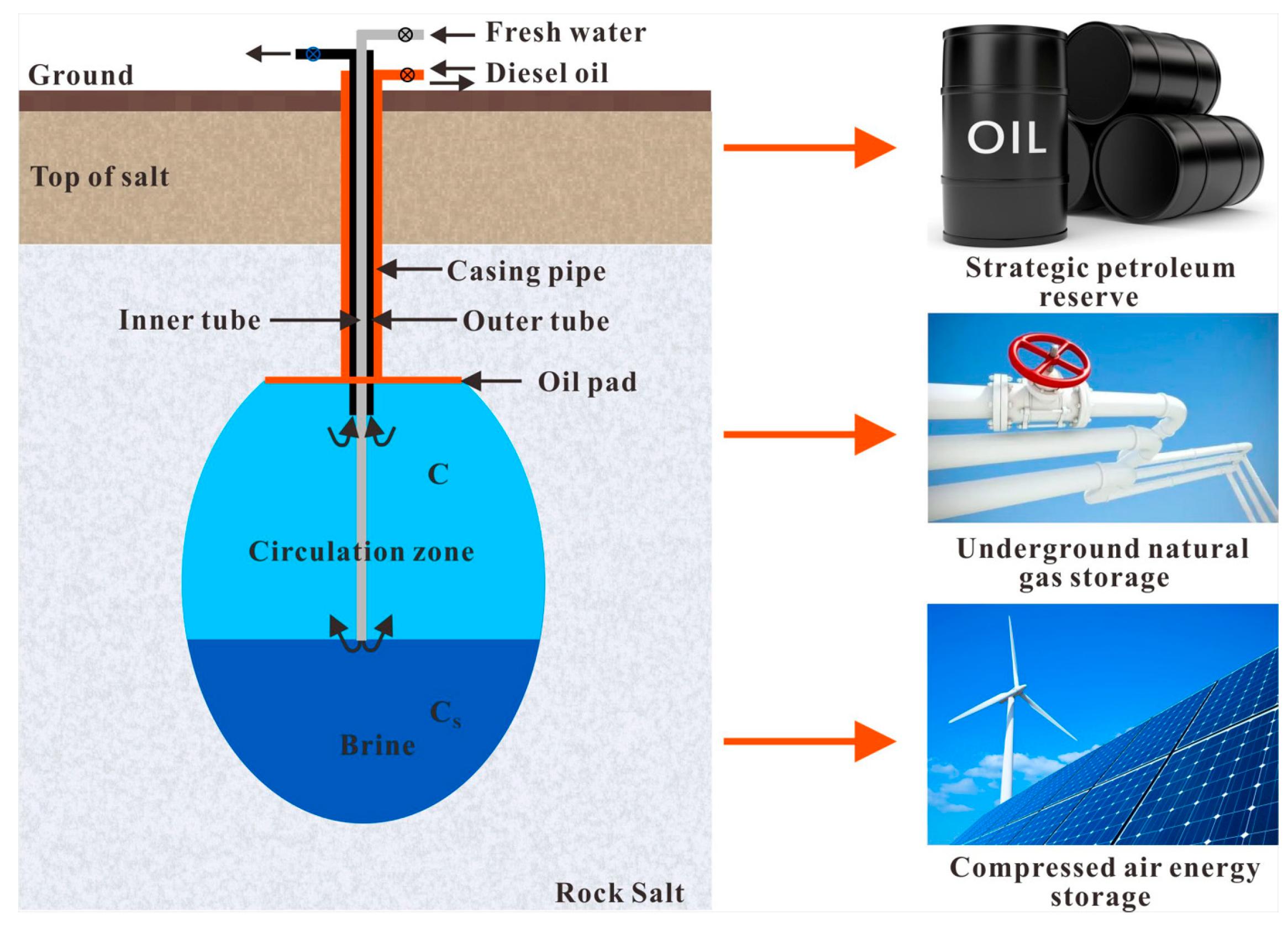
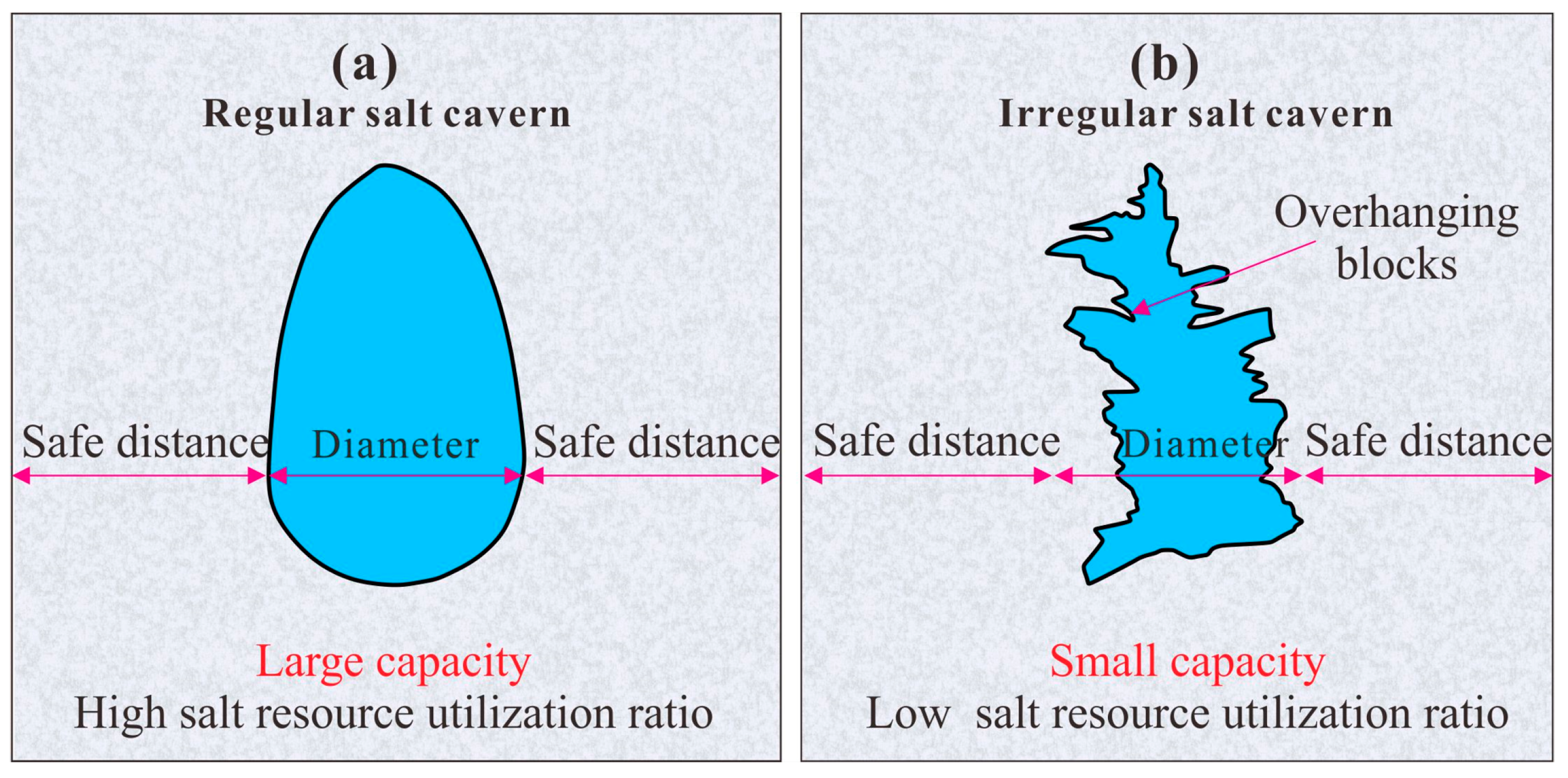

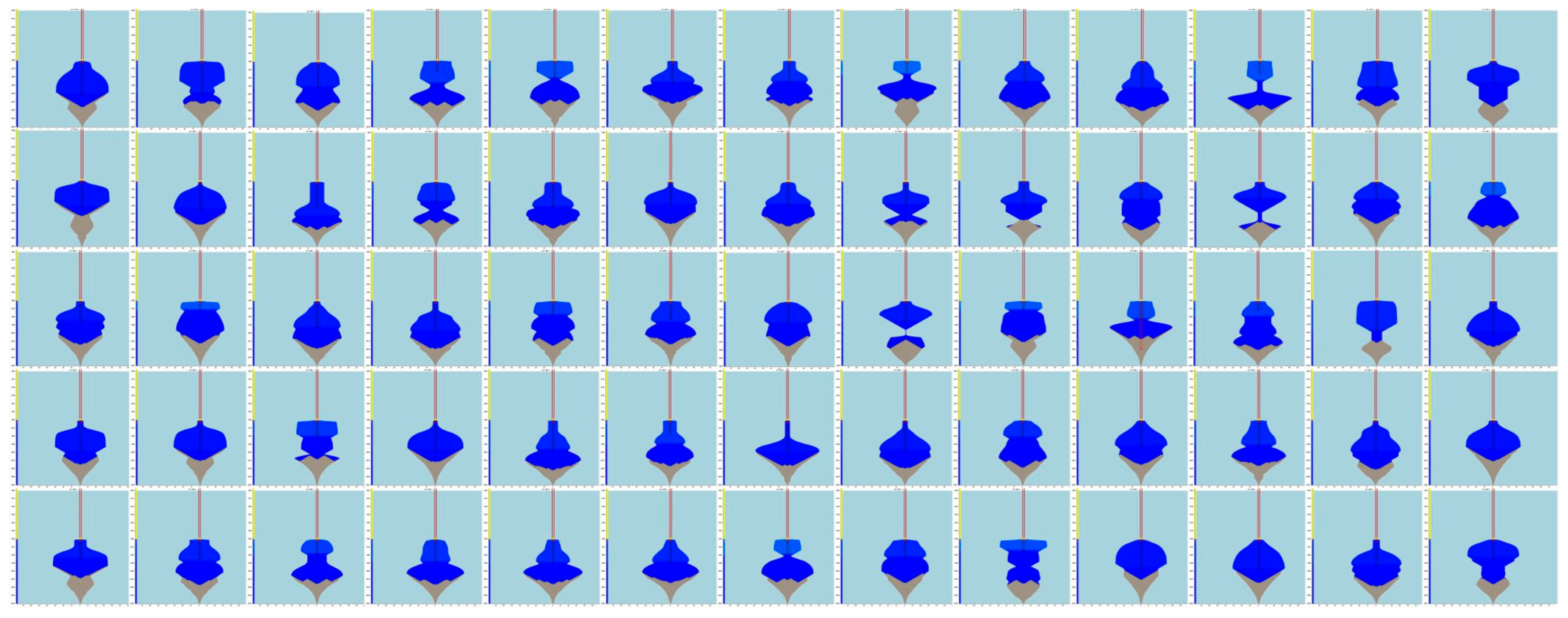
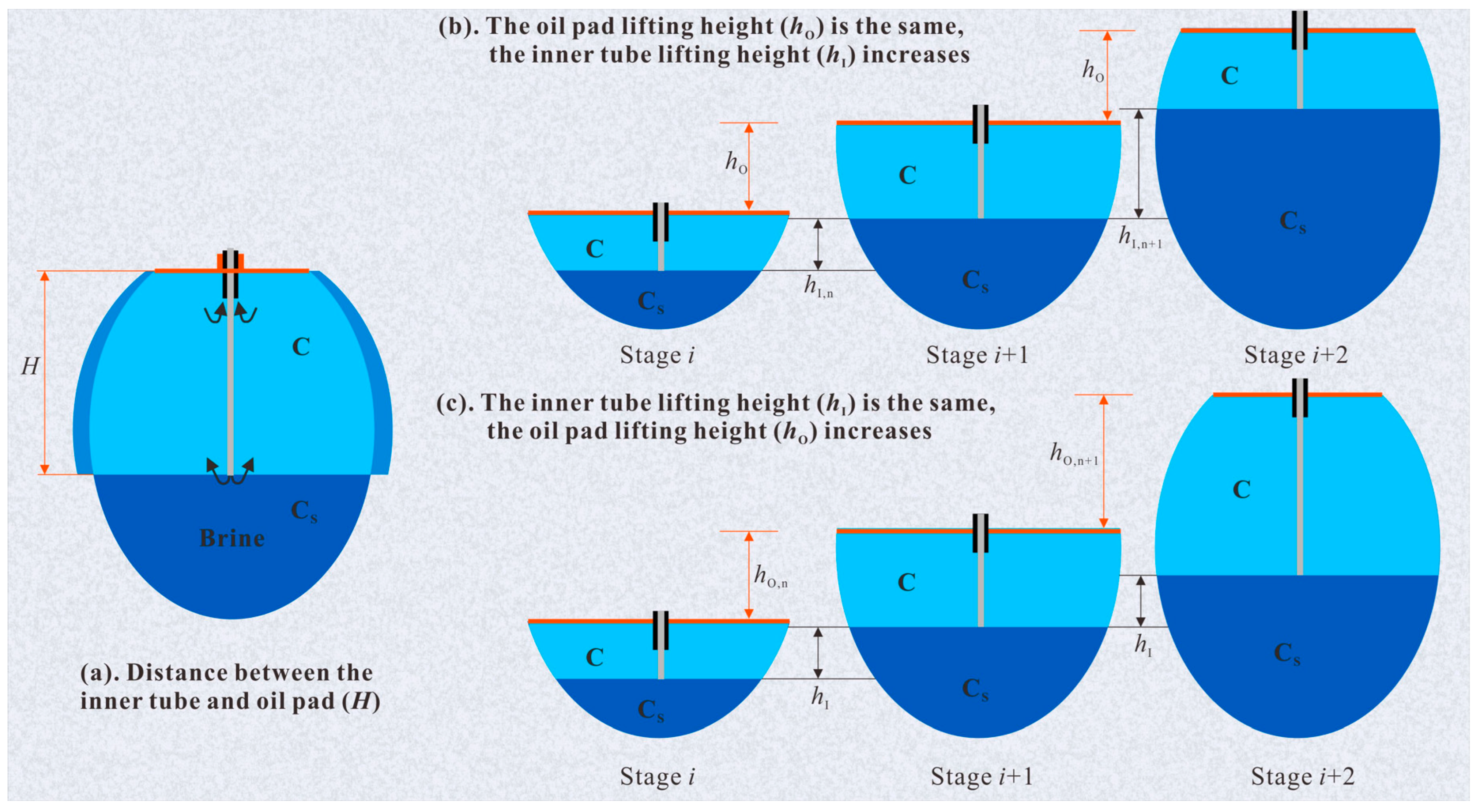
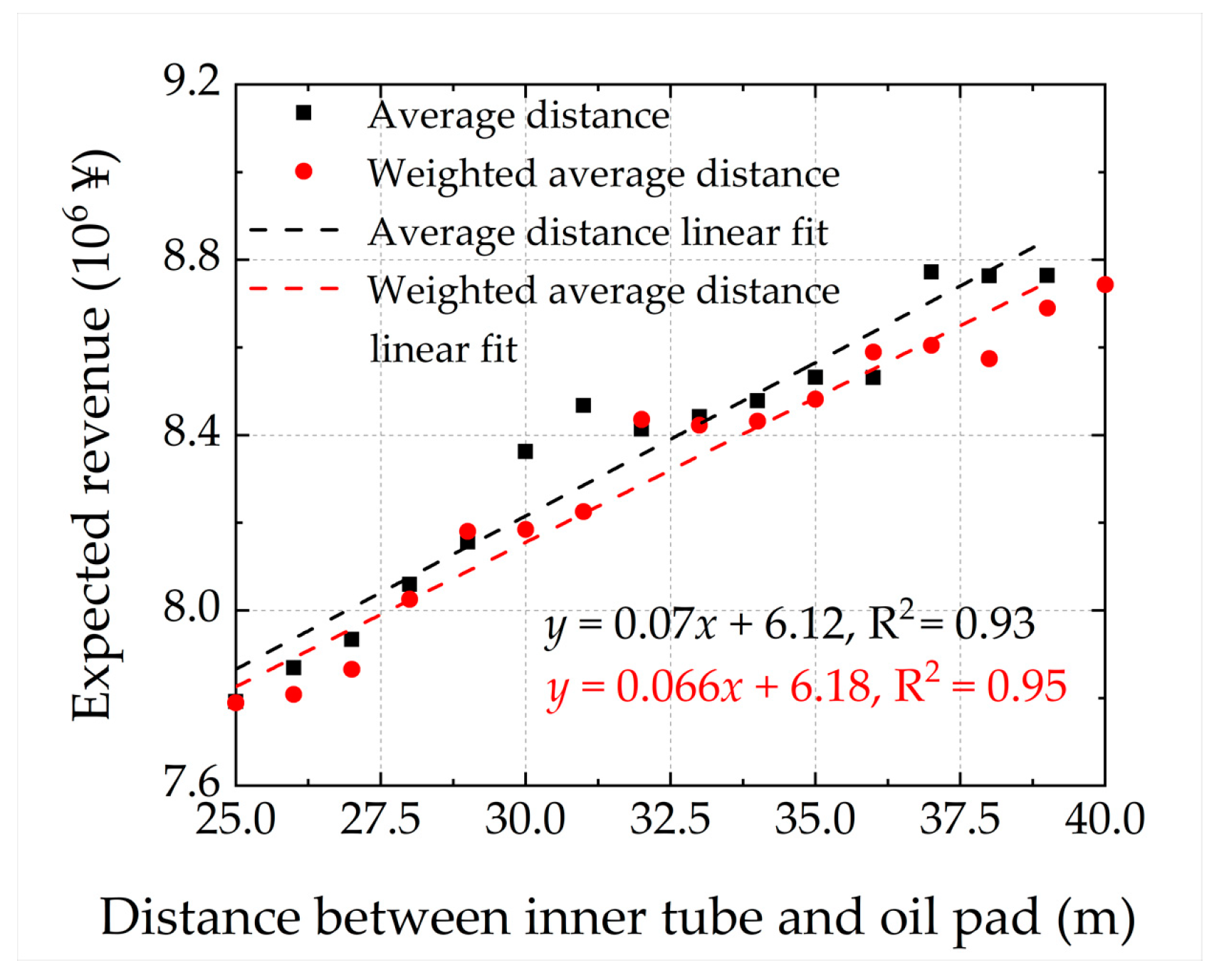

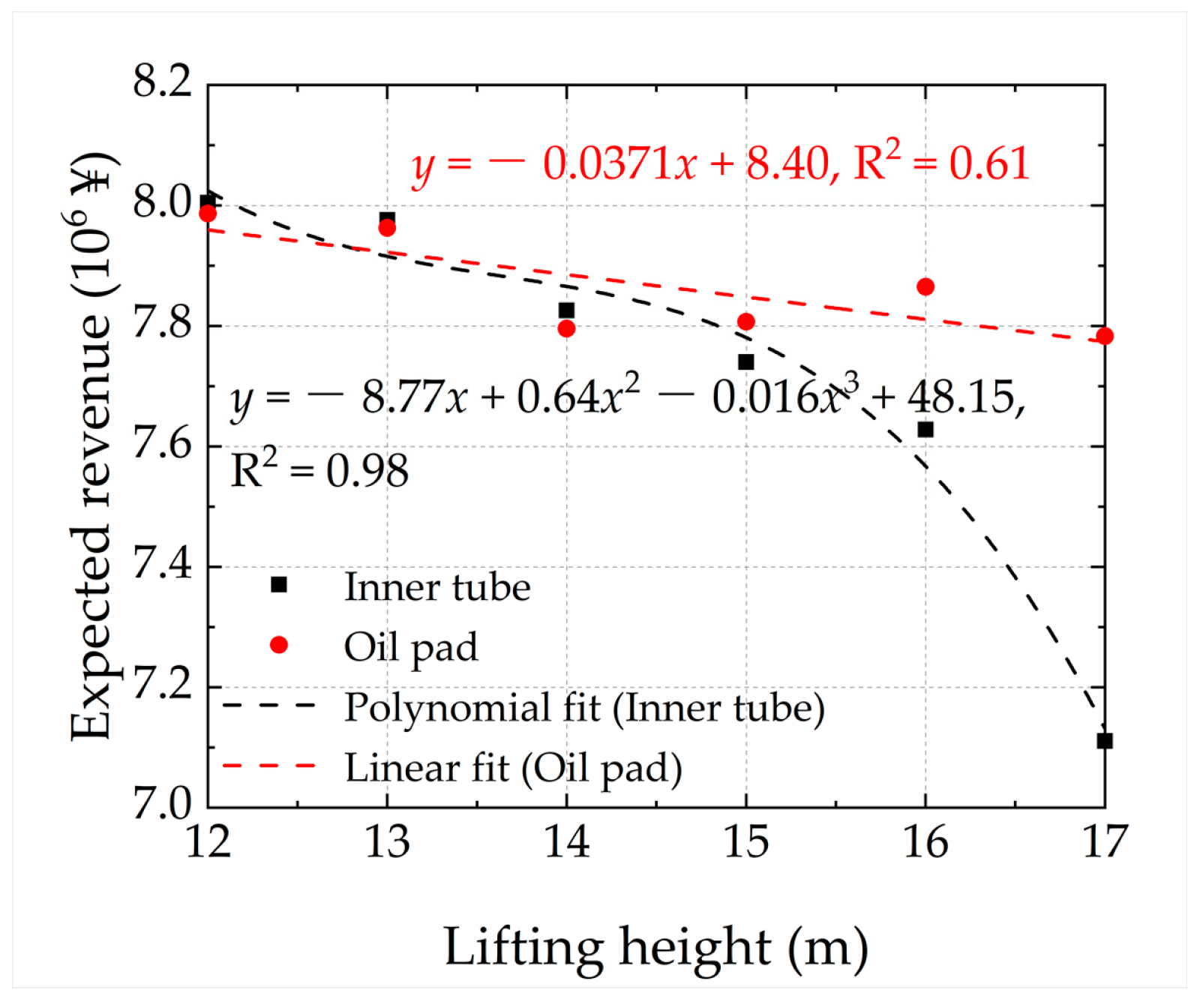
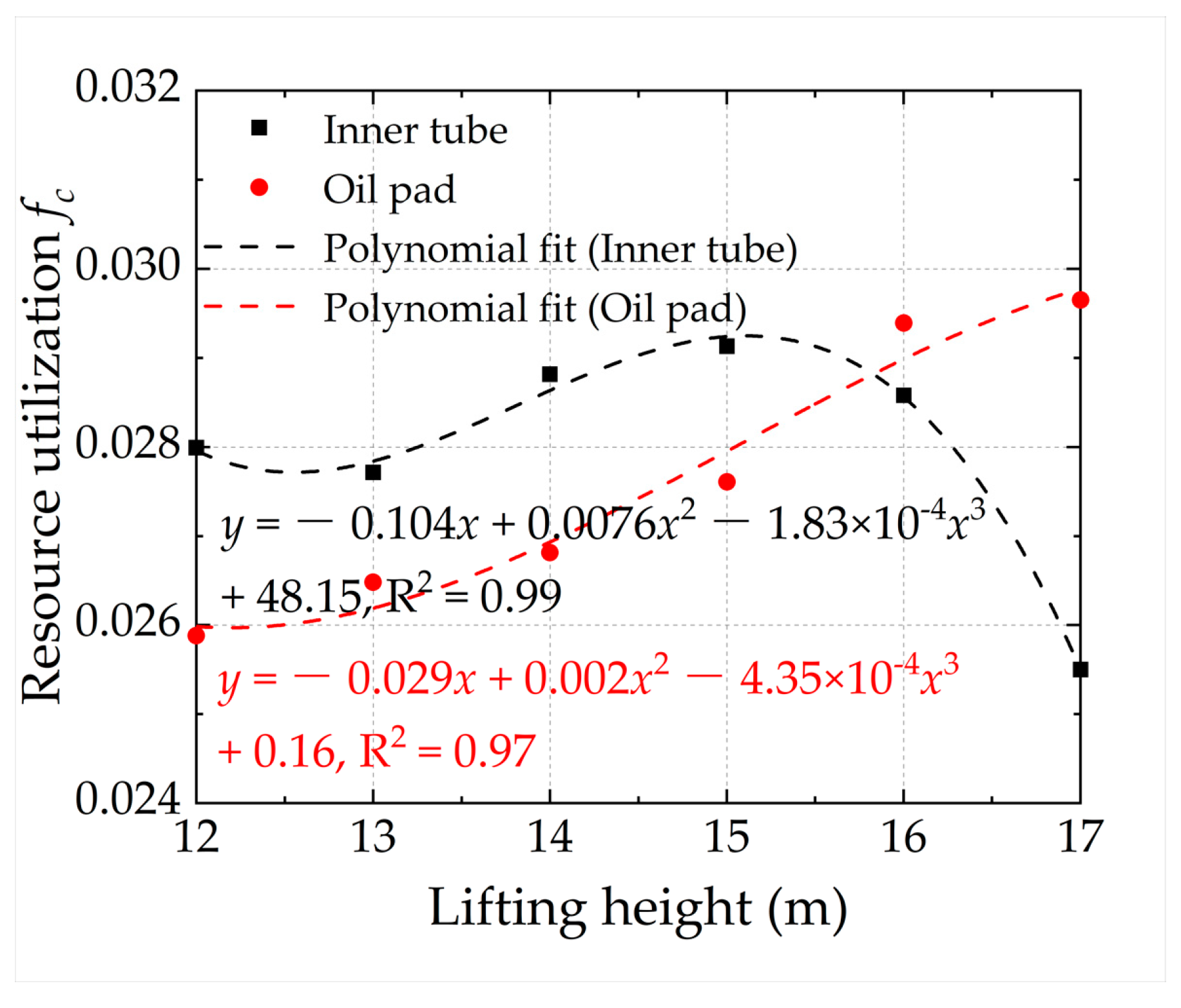
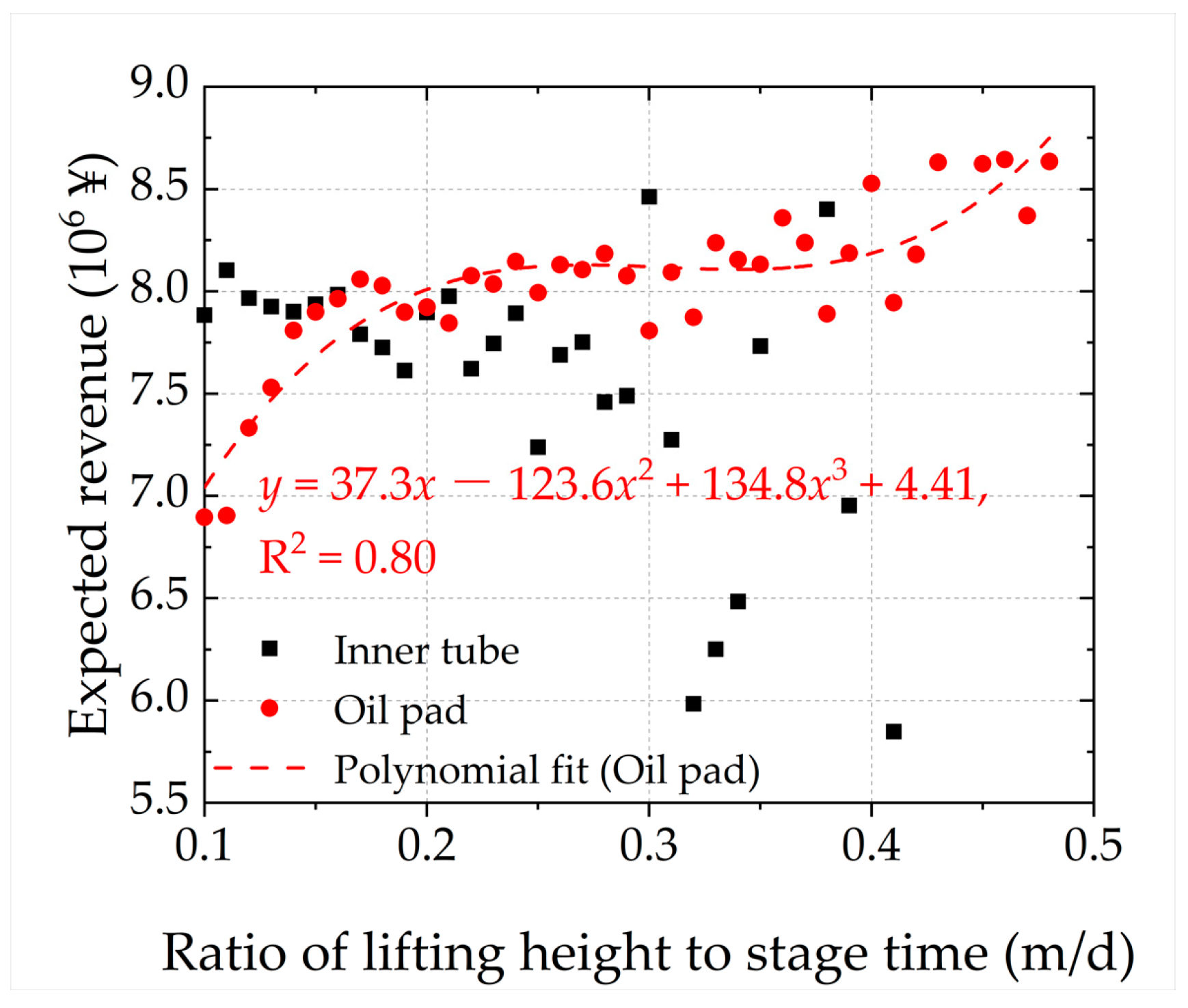

| Stage | Process Parameters | G-1 | G-2 | G-3 | G-4 | G-5 | G-6 | G-7 | G-8 |
|---|---|---|---|---|---|---|---|---|---|
| 1 | Inner tube depth (m) | 0 | 0 | 0 | 0 | 0 | 0 | 0 | 0 |
| Oil pad depth (m) | 20 | 26 | 23 | 11 | 14 | 23 | 26 | 24 | |
| Duration (days) | 55 | 26 | 47 | 27 | 22 | 60 | 47 | 40 | |
| 2 | Inner tube depth (m) | 8 | 15 | 10 | 5 | 5 | 20 | 15 | 5 |
| Oil pad depth (m) | 23 | 26 | 23 | 22 | 21 | 35 | 43 | 43 | |
| Duration (days) | 178 | 124 | 82 | 112 | 190 | 148 | 184 | 155 | |
| 3 | Inner tube depth (m) | 10 | 18 | 16 | 12 | 15 | 19 | 19 | 23 |
| Oil pad depth (m) | 26 | 31 | 30 | 24 | 46 | 62 | 58 | 65 | |
| Duration (days) | 175 | 245 | 263 | 217 | 75 | 49 | 75 | 110 | |
| 4 | Inner tube depth (m) | 26 | 28 | 25 | 24 | 31 | 22 | 45 | 38 |
| Oil pad depth (m) | 67 | 43 | 71 | 74 | 75 | 72 | 62 | 75 | |
| Duration (days) | 89 | 105 | 87 | 132 | 133 | 185 | 160 | 159 | |
| 5 | Inner tube depth (m) | 43 | 42 | 59 | 67 | 69 | 42 | 55 | 58 |
| Oil pad depth (m) | 80 | 80 | 80 | 80 | 80 | 80 | 80 | 80 | |
| Duration (days) | 103 | 100 | 121 | 112 | 180 | 158 | 134 | 136 |
| Indicators | G-1 | G-2 | G-3 | G-4 | G-5 | G-6 | G-7 | G-8 |
|---|---|---|---|---|---|---|---|---|
| Cavern volume (103 m3) | 38.57 | 43.19 | 43.33 | 43.80 | 48.06 | 84.19 | 84.19 | 84.20 |
| Maximum radius (m) | 27.2 | 30.7 | 30.7 | 29.2 | 30.6 | 35.0 | 30.7 | 29.4 |
| Expected revenue (106 ¥) | 3.92 | 4.39 | 4.41 | 4.45 | 4.89 | 8.56 | 8.56 | 8.56 |
| Resource utilization fc | 0.018 | 0.016 | 0.016 | 0.018 | 0.018 | 0.024 | 0.031 | 0.034 |
| Parameters | Distance between Inner Tube and Oil Pad | Inner Tube Lifting Height | Oil Pad Lifting Height | Ratio of Lifting Height to Duration |
|---|---|---|---|---|
| Criteria | >30 m | <15 m | >14 m | >0.2 m/d |
Disclaimer/Publisher’s Note: The statements, opinions and data contained in all publications are solely those of the individual author(s) and contributor(s) and not of MDPI and/or the editor(s). MDPI and/or the editor(s) disclaim responsibility for any injury to people or property resulting from any ideas, methods, instructions or products referred to in the content. |
© 2023 by the authors. Licensee MDPI, Basel, Switzerland. This article is an open access article distributed under the terms and conditions of the Creative Commons Attribution (CC BY) license (https://creativecommons.org/licenses/by/4.0/).
Share and Cite
Song, H.; Zhu, S.; Li, J.; Wang, Z.; Li, Q.; Ning, Z. Design Criteria for the Construction of Energy Storage Salt Cavern Considering Economic Benefits and Resource Utilization. Sustainability 2023, 15, 6870. https://doi.org/10.3390/su15086870
Song H, Zhu S, Li J, Wang Z, Li Q, Ning Z. Design Criteria for the Construction of Energy Storage Salt Cavern Considering Economic Benefits and Resource Utilization. Sustainability. 2023; 15(8):6870. https://doi.org/10.3390/su15086870
Chicago/Turabian StyleSong, Huiyong, Song Zhu, Jinlong Li, Zhuoteng Wang, Qingdong Li, and Zexu Ning. 2023. "Design Criteria for the Construction of Energy Storage Salt Cavern Considering Economic Benefits and Resource Utilization" Sustainability 15, no. 8: 6870. https://doi.org/10.3390/su15086870
APA StyleSong, H., Zhu, S., Li, J., Wang, Z., Li, Q., & Ning, Z. (2023). Design Criteria for the Construction of Energy Storage Salt Cavern Considering Economic Benefits and Resource Utilization. Sustainability, 15(8), 6870. https://doi.org/10.3390/su15086870







